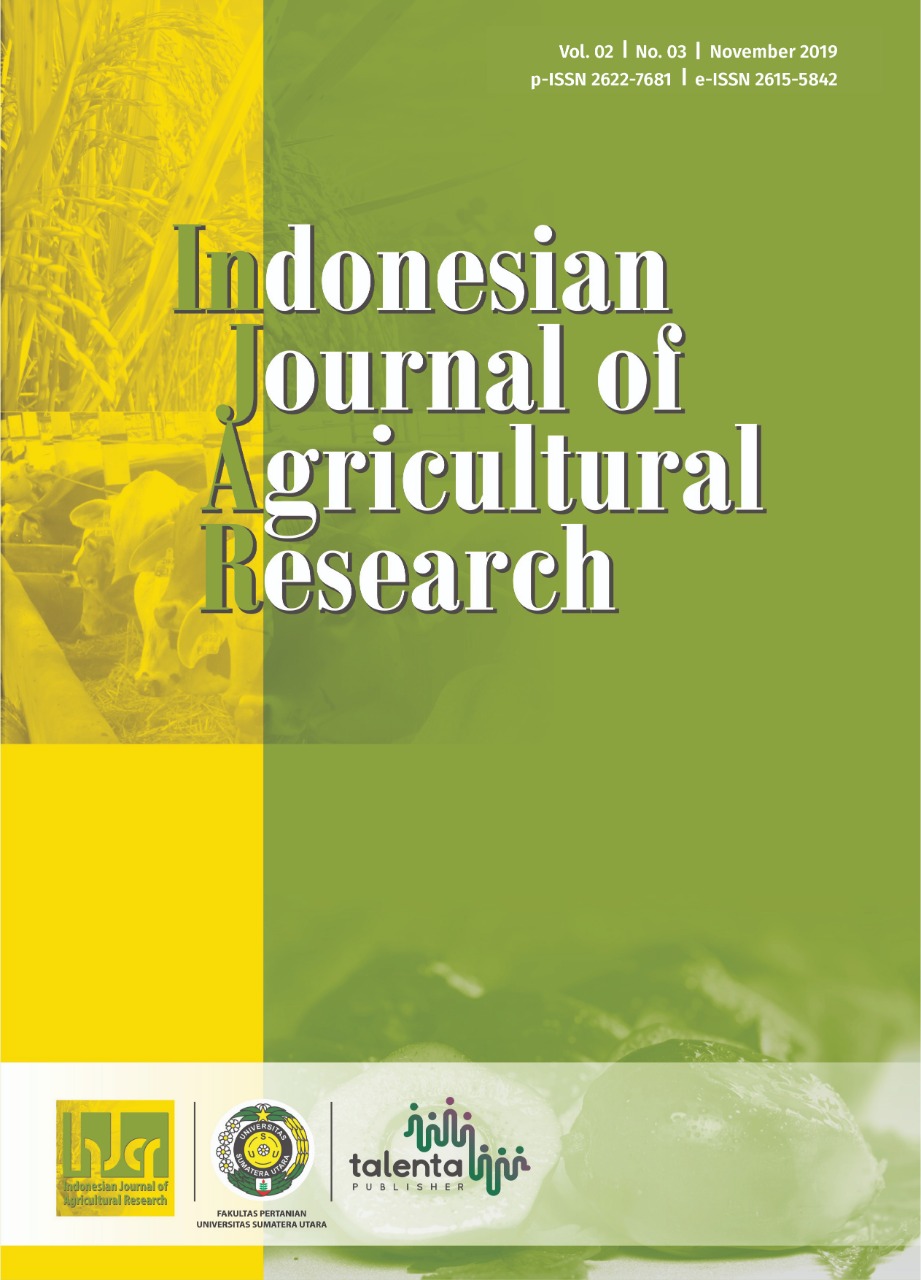Growth and Yields Response of Some Varieties of Soybean (Glycine Max (L) Merill) on Ultisol Soil
DOI:
https://doi.org/10.32734/injar.v2i3.2035Keywords:
Southeast Aceh, soybean, ultisol, varietiesAbstract
Soybean is an agricultural product that has a good nutritional value, especially Protein content. This study aims to find superior varieties that have a wide adaptation to the sour soil especially in Ultisol soils. The study was conducted in Gulo Village, Darul Hasanah Sub-District, Southeast Aceh Regency, Aceh Province, from May to September 2019. The study used a non factorial randomized block design (RBD), with 4 treatment varieties (V) levels that were repeated as many as 4 replications; namely V1: Anjasmoro Varieties, V2: Dena Varieties, V3: Deja Varieties 1, V4: Detaptive Varieties 1, Variance analysis test results showed that the plant height was 1 WAP, Age 2 WAP, Age 3 WAP, Age 4 WAP, Age 5 WAP , and Age 6 WAP had no significant effect. However the highest yield on 1 WAP was found in variety V4 (10.40) in the second test and the lowest was in the first test. V2 was second test. While the best number of segments and branches were produced by V3 treatment. The best results for the total number of pods, number of pods, total empty pods, number of sample plant seeds and weight of sample plant seeds were produced by treatment V3.
Downloads
References
Arsyad, D. M. dan M. Syam. 2000. Varietas Unggul dan Strategi Pemuliaan Kedelai di Indonesia. Penelitian dan Pengembangan Produksi Kedelai di Indonesia. Direktorat Teknologi Lingkungan. Badan Pengakajian dan Penerapan Teknologi. Pusat Penelitian dan Pengembangan Pertanian. Badan Penelitian dan Pengembangan Pertanian. Kementerian Pendidikan, Sains, Riset dan Teknologi Jerman. L.W. Gunawan,N. Sunarlim,T. Handayani, Soegiarto, W. Adil, B. Priyanto dan Suwarno (Eds).: 39-42.
Balitkabi Balai Penelitian Kacang-kacangan dan Umbi-umbian. (2011). Pengembangan Sistem Perbenihan Kedelai Berbasis Komunitas. http://balitkabi.litbang.deptan.go.id/id/hasil-penelitian-utama: accessed on 5 September 2011.
Departemen Pertanian. (2008). Panduan Pelaksanaan Sekolah Lapang Pengelolaan Tanaman Terpadu (SL-PTT) Kedelai. Jakarta: Badan Litbang Puslitbangtan.Balitkabi
Direktorat Jendral Produksi Tanaman Pangan. Departemen Pertanian. Jakarta
Fachruddin, Lisdiana, Ir. (2000). Budidaya Kacang-kacangan. Yogyakarta: Penerbit Kanisius.
Foth, H.D. (1994). Dasar-Dasar Ilmu Tanah. Yokyakarta: UGM.Press,706 pages.
Antarlina SS, Widowati S. (2009). Varietas Unggul Kedelai untuk Bahan Baku Industri Pangan. J Litbang Pertanian. 28:79-86.
Hardjowigeno, S. (1985). Klasifikasi Tanah dan Lahan. Mimbar Akademik, Jurnal Ilmiah Universitas Haluoleo, March Edition, Vol. 26 : 18 – 24.
Hilman, Y. (2005). Teknologi Produksi Kedelai di Lahan Kering Masam. Prosiding Lokakarya Pengembangan Kedelai di Lahan Sub Optimal. Puslitbangtan Bogor: p. 78-86.
Khol, G.J. (1983). Pilot Project on Integrated Soya and Food Crops Development. Reports of GTZ.
Maidl, F.X. (1996). Soil Fertility Management for Crop Production on Acid Soils. Experiment from Brazil.
Rubatzky, V.E. and M. Yamaguchi, 1998. Sayuran Dunia, Prinsip, Prodiksi dan gizi.Second Edition. Bandung: Translated by Catur Herison-Press
Subagyo, H., Suharta and Siswanto, A. B. (2004). Tanah-tanah Pertanian di Indonesia. Bogor: Pusat Penelitian dan Pengembangan Tanah dan Agroklimat (p. 21-66)
Downloads
Published
How to Cite
Issue
Section
License
Copyright (c) 2020 Indonesian Journal of Agricultural Research

This work is licensed under a Creative Commons Attribution-ShareAlike 4.0 International License.



















